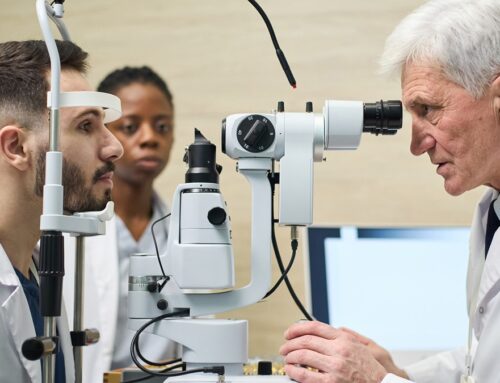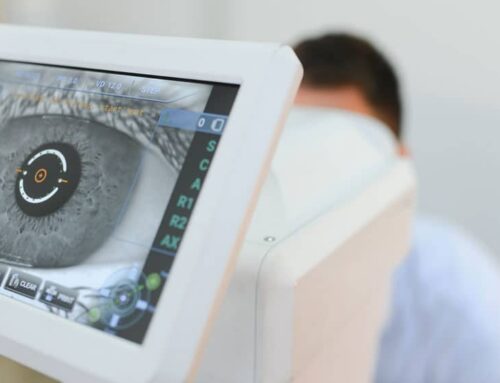Imagine a life where the first thing you reach for each morning isn’t glasses, but the day ahead. While 197.6 million adults in the U.S. muddle through a blur of corrective lenses, two notable vision correction procedures – LASIK and EVO ICL – are reshaping access to visual freedom. These aren’t just medical procedures; they’re gateways to experiencing life in stunning clarity, from loved one’s subtle expressions to a sunrise’s brilliant colors. Jump in and compare LASIK vs EVO ICL’s procedures, and unique qualities (chart below) with us to decide on which is better for you.
An Overview of LASIK vs EVO ICL Treatments
LASIK (Laser-Assisted In Situ Keratomileusis) represents a remarkable advancement in vision correction technology that’s transformed millions of lives since its FDA approval in 1999. This sophisticated procedure reshapes your cornea – the clear front surface of your eye – using precise laser technology to correct refractive errors such as nearsightedness, farsightedness, and astigmatism.
LASIK’s Standout Tech
- What sets modern LASIK apart from other vision treatments is its remarkable fusion of precision and personalization. Using wavefront-guided technology, a detailed 3D map of your eye’s unique imperfections – much like a fingerprint of your vision – is created prior to the surgery. During treatment, specialized eye-tracking cameras instantly react to and adjust for the tiniest of movements, guaranteeing flawless accuracy.
EVO ICL (Evolutionary Implantable Collamer Lens) is a 2022 FDA-approved procedure that corrects for
nearsightedness and astigmatism. Unlike LASIK, EVO ICL instead introduces a biocompatible lens that complements your eye’s existing focusing system – opening up possibilities for patients seeking freedom from glasses and contacts.
EVO’s Outcomes & Reversibility
- EVO ICL holds a remarkable 99% success rate for achieving 20/40 vision or better, while its Collamer construction – derived from collagen – means the lens can stay in your eye for extended periods with no adverse reactions.
Diving Into LASIK vs EVO ICL – Exact Techniques Used
Where each procedure begins with medicated, numbing drops and a speculum to hold your eyelids open, it’s here where the similarities between LASIK and EVO ICL end.
- During LASIK, your surgeon creates a thin, protective flap in the cornea using a femtosecond laser, a technology that operates at incredible speeds – one quadrillionth of a second. Once lifted, a second laser (the excimer laser) meticulously reshapes the underlying corneal tissue according to your prescription. Finally, the protective flap is repositioned, acting as a natural bandage while your eye heals.
- During EVO ICL, a soft, biocompatible lens is placed behind your iris through a tiny, laser-created opening. It’s then adjusted to align perfectly with your natural lens to deliver exceptional visual clarity. No incision stitches are required.
The total procedure time for LASIK is 10-30 minutes for both eyes (laser time takes 20-120 seconds/eye), whereas, EVO takes 10-15 minutes/eye totaling about 30 minutes. With both procedures being so brief, you can expect to spend 2-3 hours at the surgical center when accounting for preparation and post-surgical follow-up.
What Sets LASIK vs. EVO ICL Apart From Each Other?
At Best LASIK Surgeons, we understand the enormity of choosing between vision treatments, which is why we’ve made it our goal to give you all the information you need to make the best decision for your eyes. Here’s an easy-to-understand breakdown of the key differences between LASIK and EVO ICL.
| Feature | LASIK vs. EVO ICL | |
|---|---|---|
| Procedure Type | Laser corneal reshaping via tissue removal | Biocompatible lens implantation |
| Reversibility | Permanent | Removable and replaceable |
| Age Requirements | FDA-approved for 18+ | Ages 21-45 |
| Conditions Treated | Myopia, hyperopia, astigmatism | Myopia, astigmatism |
| Candidacy | Requires adequate corneal thickness; stable prescription | Excellent for thin corneas; better for higher prescriptions |
| Recovery | Most patients return to daily activities within 24-48 hours | Initial recovery 24-48 hours; full stabilization within 1-2 weeks |
| UV Protection | None | Yes |
| Risks | Rarely infection/glaucoma, dry eye during healing | Rarely infection, the V5 model eliminates glaucoma risk |
| Night Vision Effects | Possible glare/halos (temporary) | Possible glare/light sensitivity but less severe (temporary) |
| Flexibility & Results | Permanent change and results | Long-lasting – can be adjusted as vision needs to change |
| Cost | $3,000-$4,500/eye. Lower cost as it is established and no material cost. | $3,000-$5,000/eye. Higher initial investment due to advanced lens technology |
Your Path to Visual Freedom Is Within Reach
Don’t wake up to another blurry morning. With the advancements in EVO ICL vs LASIK, achieving crystal-clear vision is just a consultation away. Use our national directory to find a top-rated surgeon in your area, and get ready to see a fully transformed world.







